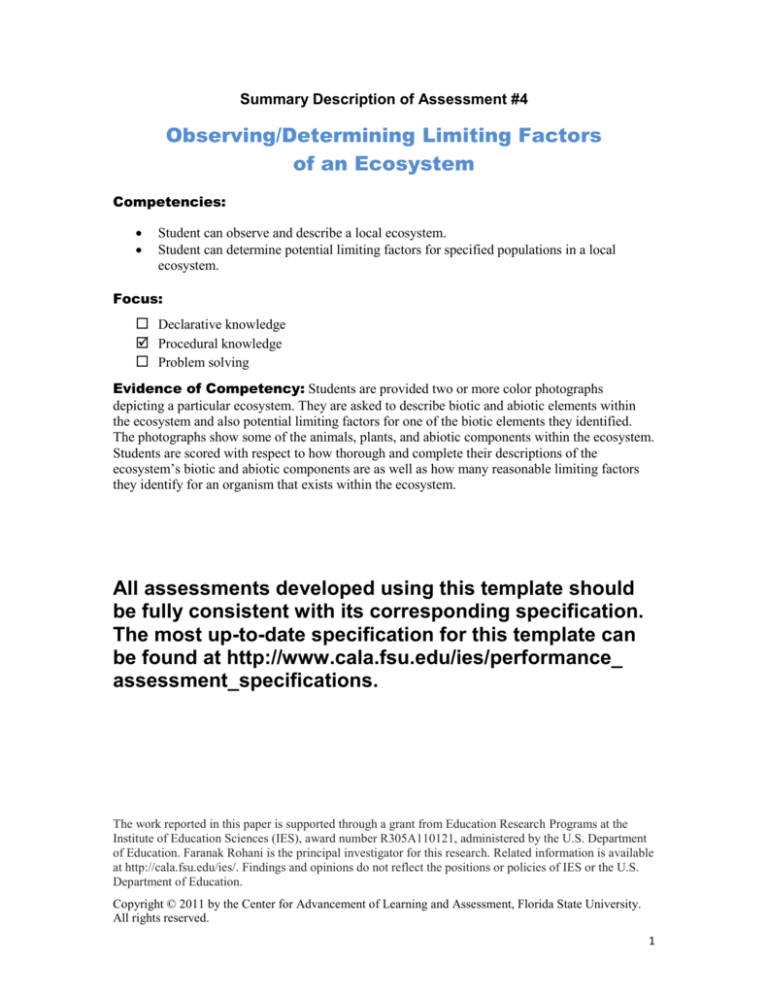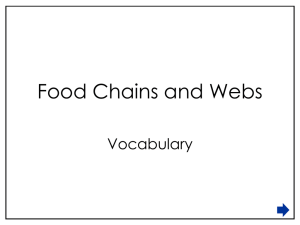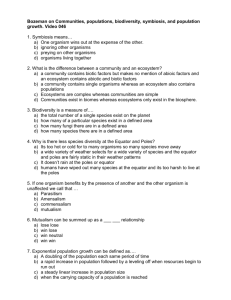
Summary Description of Assessment #4
Observing/Determining Limiting Factors
of an Ecosystem
Competencies:
Student can observe and describe a local ecosystem.
Student can determine potential limiting factors for specified populations in a local
ecosystem.
Focus:
Declarative knowledge
Procedural knowledge
Problem solving
Evidence of Competency: Students are provided two or more color photographs
depicting a particular ecosystem. They are asked to describe biotic and abiotic elements within
the ecosystem and also potential limiting factors for one of the biotic elements they identified.
The photographs show some of the animals, plants, and abiotic components within the ecosystem.
Students are scored with respect to how thorough and complete their descriptions of the
ecosystem’s biotic and abiotic components are as well as how many reasonable limiting factors
they identify for an organism that exists within the ecosystem.
All assessments developed using this template should
be fully consistent with its corresponding specification.
The most up-to-date specification for this template can
be found at http://www.cala.fsu.edu/ies/performance_
assessment_specifications.
The work reported in this paper is supported through a grant from Education Research Programs at the
Institute of Education Sciences (IES), award number R305A110121, administered by the U.S. Department
of Education. Faranak Rohani is the principal investigator for this research. Related information is available
at http://cala.fsu.edu/ies/. Findings and opinions do not reflect the positions or policies of IES or the U.S.
Department of Education.
Copyright © 2011 by the Center for Advancement of Learning and Assessment, Florida State University.
All rights reserved.
1
Performance Assessment #4
Describing an Ecosystem at ___________________
Task students are asked to perform:
Students are provided a brief overview of what an ecosystem is. They are provided the two
color photographs (see Appendix A) taken at a location on the ________________________.
Students are first asked to write brief descriptions of three biotic and two abiotic components
within the ecosystem shown in the ____________ photographs. Students’ description of each
biotic component is to include at least one physical characteristic that is key to the organism’s
reproduction or survival and the organism’s role in the ecosystem. The description of each of
the abiotic components is to include the role in or the effects on organisms within the
ecosystem.
Students are then asked to identify five potentially limiting factors for one organism they
select from the photographs.
The assessment is not to be scored if it becomes apparent the student in familiar with less
than three animals and/or plants shown in the photographs.
Related prior knowledge or skills students must have:
Students are able to briefly describe what is meant by “limiting factors.”
Required materials and resources:
The two color photographs taken at the _______________, each 3” 5” or larger.
Written instruction provided in Appendix A.
Paper on which the student’s observations are recorded for later scoring.
Instruction given student:
See Written Instructions for Students (Appendix A).
Guidelines that influence administering this performance assessment when used summatively:
Students are to work alone to complete this task.
The teacher may name, but not describe, items in the photographs.
The teacher may clarify instructions not understood by a student, as long as the
clarification does not provide examples of items associated with the ecosystem.
Similarly, the teacher may prompt a student to describe what is seen in the photographs,
as long as the prompting does not provide examples of items associated with the
ecosystem.
2
Scoring Plan for this performance assessment:
Regarding all scoring plans, partial credit is never awarded for any items within the scoring plan, even
when multiple points are involved. Credit is to be awarded in full or not at all.
Grammar, spelling, or other factors not directly related to the competency being assessed are not reflected
in the scoring plan. Using professional judgment, however, you are encouraged to provide students
feedback on these additional factors that are not assigned points in this scoring plan.
This assessment is not to be scored if it becomes apparent the student is familiar with less
than three animals and/or plants shown in the photograph.
Descriptions of Living Organisms
Student describes a physical characteristic visible in a photograph key to organism’s
reproduction or survival in ecosystem for a 1st living organism.
1
Student describes a role the 1st living organism plays within the ecosystem.
1
Student similarly describes a physical characteristic of a 2nd living organism.
1
Student similarly describes a role of the 2nd living organism.
1
Student similarly describes a physical characteristic of a 3rd living organism.
1
Student similarly describes a role of the 3rd living organism.
1
Descriptions of Nonliving Things
For a 1st nonliving thing, student describes that thing’s role or how it affects organisms
in the ecosystem.
Note: Nonliving thing must be visible in or reasonably inferred from photographs.
1
For a 2nd nonliving thing, student similarly describes the role or how it affects
organisms.
1
For Selected Living Organism, Identification of Potential Limiting Factors
Student states a reasonable limiting factor for selected organism.
Note: Limiting factor must be a factor such as food, shelter, or disease, visible or
not in photograph, reasonable for the present ecosystem.
1
Student states a 2nd reasonable limiting factor for same organism.
1
Student states a 3rd reasonable limiting factor for same organism.
1
Student states a 4th reasonable limiting factor for same organism.
1
Student states a 5th reasonable limiting factor for same organism.
1
3
Appendix A
Written Instructions for Students
Describing an Ecosystem at ___________________
An ecosystem is a system of living and nonliving things that interact with each other in
various ways. You can find ecosystems in parks, forests, backyards, in and near rivers and
ponds, and in many other places.
On the following pages are two photographs taken at a location on the __________________
_________. They provide two views of an ecosystem. You will be writing a description of
this ecosystem. Look carefully at the two photographs. In your description, only describe
what you can see in at least one of the photographs.
Part 1
Identify and describe three living organisms you can see in the photographs. This includes
animals and plants. Write your answers on this paper.
1st Organism:
Name the first living organism you identified: __________________________________
Describe at least one physical characteristic that is important to this organism’s
reproduction or survival in this ecosystem:
Describe this organism’s role or niche within this ecosystem:
2nd Organism:
Name the second living organism you identified: ________________________________
Describe at least one physical characteristic that is important to this organism’s
reproduction or survival in this ecosystem:
Describe this organism’s role or niche within this ecosystem:
3rd Organism:
Name the third living organism you identified: __________________________________
Describe at least one physical characteristic that is important to this organism’s
reproduction or survival in this ecosystem:
Describe this organism’s role or niche within this ecosystem:
4
Part 2
Identify and describe two nonliving things that affect at least some of the living organisms
you see in the photographs.
1st Nonliving Thing:
Name the first nonliving thing you identified: __________________________________
Describe its role or how it affects living things within this ecosystem:
2nd Nonliving Thing:
Name the second nonliving thing you identified: ________________________________
Describe its role or how it affects living things within this ecosystem:
Part 3
Now you are going to identify potential “limiting factors” that might limit the growth or
reproduction of a living organism you see in the photographs. You may or may not see these
limiting factors in the photographs, so you will have to rely on what you know to be a reasonable
limiting factor that could affect this living organism.
Write below the name of the living organism that you will list limiting factors for:
_______________________________
List limiting factors for this living organism. For each limiting factor, explain how or why this
factor might be limiting for the organism. You will receive one point for each correct limiting
factor, up to a maximum of five points.
1st limiting factor:
2nd limiting factor:
3rd limiting factor:
4th limiting factor:
5th limiting factor:
5









